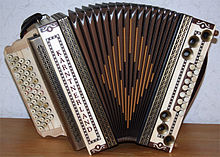
The Steirische Harmonika (Austrian German pronunciation: [ˈʃtaɪrɪʃɛ harˈmoːnika]) is a type of bisonoric diatonic button accordion important to the alpine folk music of Croatia (Hrvatsko zagorje), Slovenia, the Czech Republic, Austria, the German state of Bavaria, and the Italian South Tyrol. The Steirische Harmonika is distinguished from other diatonic button accordions by its typically richer bass notes, and by the presence of one key per scale row that has the same tone on both compression and expansion of the bellows, called a Gleichton. The bass notes earn the distinction Helikonbässe because they use bigger reeds with duralumin reed frames and a special chamber construction that amplifies its bass tones to give it a loud sound reminiscent of a Helicon tuba.
The name "Steirische Harmonika" literally translates from German as Styrian accordion; the use of the adjective steirische stems from the Viennese dialect. Steirische refers to the state of Steiermark (Styria), or Štajerska in Slovenian. This type of harmonica originated in Styria in the city of Windischgraz (or Slovenj Gradec in Slovenian), after the invention of the helikon bass reed by Franz Lubas in 1878.